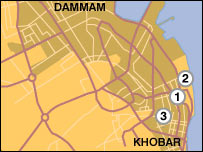Photograph Albums Archive | Saudi Arabia
Qatif and Al-Khobar, Saudi Arabia
26 February - 15 March, 2004
Ahlan wa sahlan
Click on the thumbnail picture to view the full size picture.
I spent almost three weeks in Saudi Arabia, but unfortunately I did not get to see as much of it as I would have liked, as I worked every day that I was there except for one jetlag recovery day just after I arrived.
Home, Sweet Home
at the Ryzayat Motel compound
 At least it seemed that way when I was there, although warnings were in the
always in the air. However, the
attacks of May 29 really brought those warnings
into sharper perspective, as the Petroleum Center (1) and Apicorp (2) are less
than a half mile away from the Ryzayat Motel compound where I was, and the
Oasis Resort compound
(3) is about a half mile on the other side. We passed both the
Petroleum Center and the
Oasis Resort on our way to and from work each day.
At least it seemed that way when I was there, although warnings were in the
always in the air. However, the
attacks of May 29 really brought those warnings
into sharper perspective, as the Petroleum Center (1) and Apicorp (2) are less
than a half mile away from the Ryzayat Motel compound where I was, and the
Oasis Resort compound
(3) is about a half mile on the other side. We passed both the
Petroleum Center and the
Oasis Resort on our way to and from work each day.
The courtyard just outside my room, which is on the ground floor at the right end. I never did get to try the pool, although the water was a bit cold.
The inside of my room was very similar to many hotel rooms, although with more storage and a small refrigerator for keeping my stash of non-alcoholic beer. The computer, used for late night work, email and Internet phone call back home, normally occupied the table when I was home.
Security was everywhere, particularly at the living compounds. Traffic barriers made zigzag driving skills a necessity. However, our compound, which had mostly European and Indian expatriates, had not yet rated a machine gun like this one of eight at Bill Anderson's compound, which had mostly Americans.
Work, Sweet Work
Qatif South GOSP (Gas and Oil Separation Plant)
The Engineering Control Room with most computers for the engineers and programmers installed for testing. My home away from home, particularly near the server cabinets, filled with things like clustered servers, RAID5 disk arrays, and other geeky, nerdy things.
Travel to and from Work
One cannot go anywhere without seeing mosques and minarets, and one is never out of sight unless completely away from civilization.
Arabic is read right-to-left, except when one comes to numbers, which are read left-to-right, but in the right-to-left flow of things. I managed to learn the numbers while here, but not many of the Arabic letters, for which there are four variations of most, whether used alone or in the initial, medial or final position.
My favorite sign had an interesting graphical representation of "05" (sifir khamsa), something coming in the next year, I assume, although I always forgot to ask someone what the sign was really about.
The main danger is the way people drive. Saudi Arabia has the highest road death rate in the world. Highway codes are generally ignored, and intermittently enforced. Yellow lines seem to be invisible and often straddled, like when exiting with three lanes of cars in a one-lane freeway exit. Someone in front not going fast enough? Just pass on the shoulder.
Traffic checkpoints are common, like this one on our way to the project site. Sometimes passports are checked, but often one is just waved through. One must never act like one is in a hurry. One tries to avoid the regular ones on the freeway, as they often cause a long backup.
One must always be prepared to stop for animals on the road. Goats are common, but we never did see any kangaroos hinted at by the nursery sign we passed every day.
Much of the Eastern Province is a low-lying area containing a number of sabkhas (salt flats). In many places this is being filled with construction debris to raise the land above the water table, a common site on our daily drive.
Shopping in Al-Khobar
The Khobar Corniche along the water is the main center for entertainment, including the ever-present McDonalds. Saudi Arabia is the biggest consumer of American junk food outside the US — and as a result now has a serious obesity problem, especially among teenagers.
I didn't find any rugs that I was excited enough to want to carry back on the plane, and elected to just browse.
I bought gold instead, a 6-band puzzle ring, which I have had the pleasure of putting back together three different times after it came apart unexpectedly.
Puzzles rings are an intriguing piece of jewelry originating centuries ago in the Middle East among nomadic tribes, originally intended to motivate a married woman to remain faithful. The theory was that a woman would first have to remove her wedding band to commit adultery, hiding her marital status. Since the rings are made up of interlocking bands that required knowledge that only the husband held the secret to assemble, the ring once removed from her fingers would fall apart — thus incriminating the guilty. In some areas of Turkey, they are still the most common wedding bands worn.
Fractured English is universal, as can be seen on a sign outside a restaurant bathroom.
All pictures are jpeg (jpg) 24-bits, 144 dpi format with 1024 pixels in the largest dimension. Higher resolution pictures are generally available, up to 1712 x 1368, as tif, jpeg/jpg, gif, tga, png, pcx, or bmp formats. Please email me if you are interested in these other formats.




















































